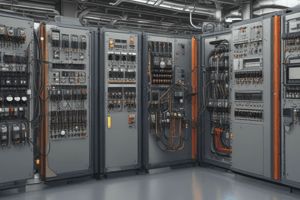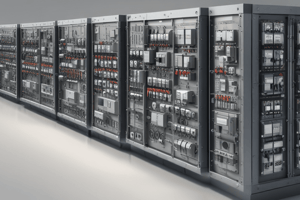Podcast
Questions and Answers
Which of the following is a common programming language used in PLCs?
Which of the following is a common programming language used in PLCs?
- Python
- Ladder Logic (correct)
- C++
- Java
What is the main function of PLCs?
What is the main function of PLCs?
- Interacting with the external world through sensors
- Programming complex algorithms
- Executing a set of instructions to control the operation of machines (correct)
- Generating reports based on input conditions
What do PLCs use to collect data from sensors and switches?
What do PLCs use to collect data from sensors and switches?
- Report generation
- Input modules (correct)
- Output modules
- Programming languages
What do PLCs use to control actuators and other devices?
What do PLCs use to control actuators and other devices?
Which type of diagrams are commonly used in programming PLCs?
Which type of diagrams are commonly used in programming PLCs?
How do PLCs contribute to safety in industrial settings?
How do PLCs contribute to safety in industrial settings?
What is the main characteristic of PLCs in terms of timing?
What is the main characteristic of PLCs in terms of timing?
Why are PLCs considered cost-effective?
Why are PLCs considered cost-effective?
In which industry or application are PLCs commonly used to control assembly lines and robotic systems?
In which industry or application are PLCs commonly used to control assembly lines and robotic systems?
What is the significance of the scalability of PLC systems?
What is the significance of the scalability of PLC systems?
Study Notes
PLCs Overview
- A common programming language used in PLCs is Ladder Logic (LAD).
- The main function of PLCs is to control and monitor industrial processes and machines.
Data Collection and Control
- PLCs use input modules to collect data from sensors and switches.
- PLCs use output modules to control actuators and other devices.
Programming PLCs
- Ladder Diagrams (LD) are commonly used in programming PLCs.
- These diagrams are used to create a program that can be easily understood by the PLC.
Safety and Cost-Effectiveness
- PLCs contribute to safety in industrial settings by providing real-time monitoring and control of processes, reducing the risk of accidents.
- PLCs are considered cost-effective because they reduce the need for manual intervention and can be easily programmed and reprogrammed.
Timing and Applications
- The main characteristic of PLCs in terms of timing is their real-time capability, allowing them to respond quickly to changes in the process.
- PLCs are commonly used in the manufacturing industry to control assembly lines and robotic systems.
Scalability
- The scalability of PLC systems is significant because it allows them to be easily expanded or modified as needed, making them a flexible solution for industrial automation.
Studying That Suits You
Use AI to generate personalized quizzes and flashcards to suit your learning preferences.
Description
Test your knowledge on the content covered in Unit-4 of the PLC & Automation handbook. This quiz covers topics such as types of PLC, PLC architecture, addressing of Mitsubishi & Siemens PLC, ladder logic, and logic development using basic, universal, and exclusive logic gates.





